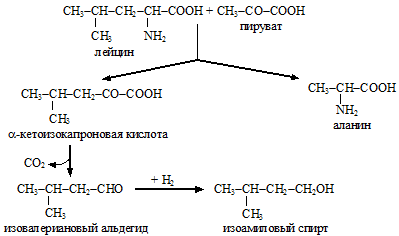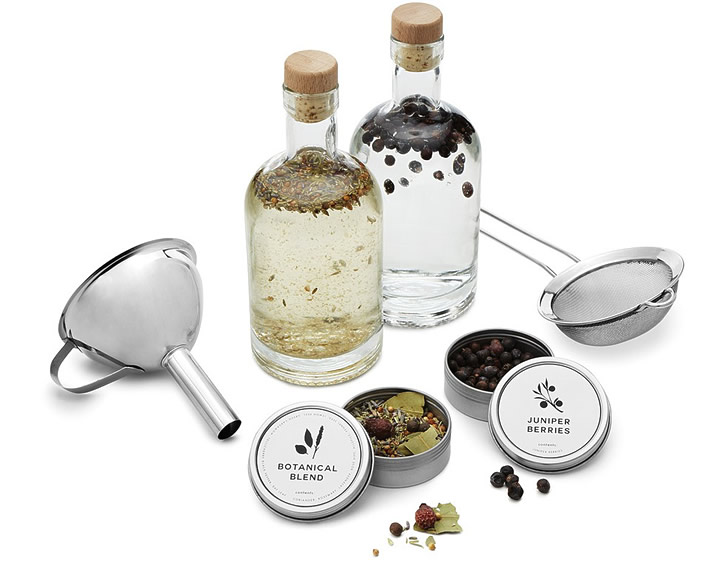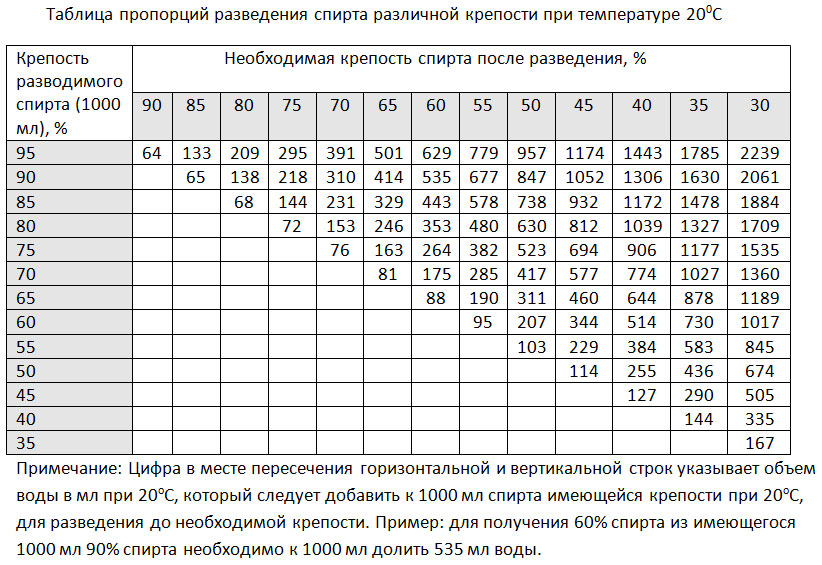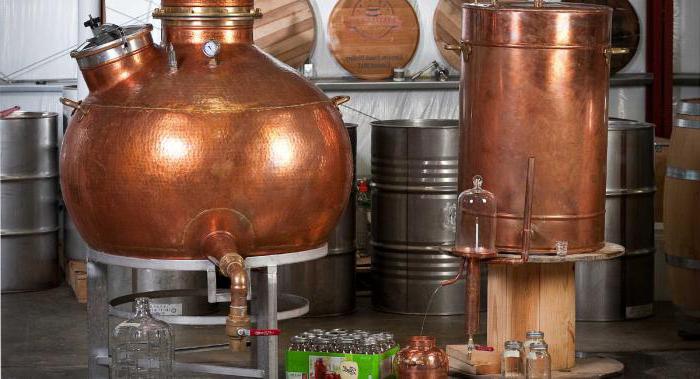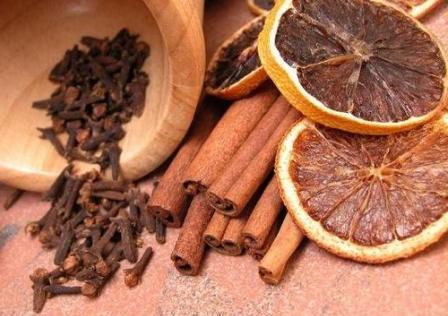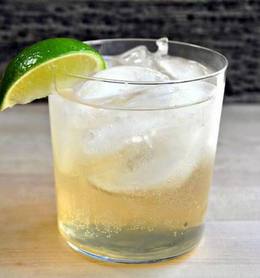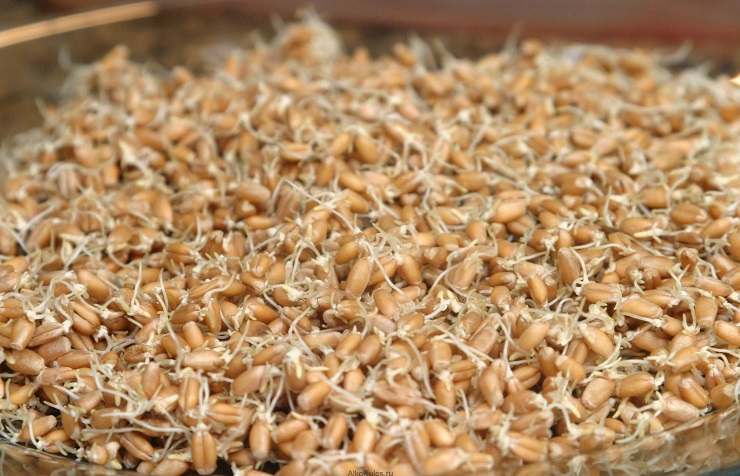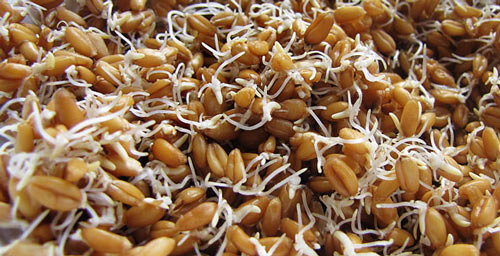Gin from moonshine at home. Moonshine gin: a home-made recipe
There is a status of one of the most distinctive and popular alcoholic drinks of our time. In our country, this alcohol also has many fans. However, not everyone knows that anyone can make gin or juniper vodka at home.
The basic recipe for this strong alcohol is quite simple. It traditionally includes wheat moonshine and juniper berries. Often some spices are added to them.
I want to bring to your attention two simple and proven recipes that allow you to cook your own homemade gin.
Classic recipe
To make gin at home, a moonshine with a steamer is best suited. For those who do not know, this is a special device that allows you to clean moonshine from harmful substances and impurities. However, if you do not have it, then it is not too scary. You just have to further separate the product into fractions, folding the “heads” and “tails”.
Remember, you cannot cook gin without distillation. If you just pour the juniper berries with alcohol and stand for some time, then the result will be the usual juniper tincture.
So, we need the following ingredients:
- double distillation purified moonshine with a strength of 50 degrees - 3 liters;
- juniper berries - 60-65 berries;
- the orange portion of the fresh orange peel is 7.5-8 grams;
- yellow portion of fresh lemon peel - 3-4.5 grams;
- ground cinnamon - 3-3.5 grams;
- fennel and anise of 1.5 grams.
Before I move on to the very recipe for home gin, I want to note two important points.
Firstly, instead of moonshine, you can opt for high-quality vodka or diluted ethyl alcohol. This is perfectly acceptable. However, in my opinion, the gin obtained from it will have a more modest taste.
Secondly, no one restricts you in experiments with spices. I recommend the first time to strictly adhere to the recipe. So, you get the reference taste of the drink. Then you can experiment with plenty of spices. You can change their number, enhancing certain taste notes. Either completely supplement or replace with something else. For example, try adding a few grams of licorice or hyssop (blue hypericum) to your gin. But the number of citrus zest and juniper berries should remain unchanged.

1. All components are placed in a glass container of a suitable volume. Pour the selected alcohol base there. Close the lid tightly and insist for 7-10 days at room temperature in a dark pantry.
2. After this time, we filter the resulting tincture through cotton wool. Then we breed with clean water to a fortress of 33-35 degrees. It is better to use spring or well water.
3. Pour the tincture into the moonshine and distill. First of all, we select the "head". If your alcohol base was of very high quality, then you can select the first 20-50 ml of yield. If you are unsure of the excellent quality of alcohol, then play it safe and take 100-120 ml. You can’t drink “heads”.
The selection of the "body" should be completed with a fortress of 50 degrees in the stream. This is our goal. Then “tails” begin to go, which cannot be drunk, but can be used to fix mash for future batches of moonshine.
If the selection of the “body” is not completed in a timely manner, then the genie will become cloudy. And the whole process will go down the drain. So be careful.
4. Bred our gin with spring water to 44-48 degrees. You can’t lower the fortress further. Otherwise, citrus halftones will disappear from the bouquet and taste of gin.
Plymouth Recipe

Historically, the English city of Plymouth is closely associated with the production of gin. The classic Plymouth Gin has its own brighter and more saturated nature, which distinguishes it from the dry London counterpart.
Making Plymouth gin at home is a bit more complicated. However, if you cope with a few additional difficulties and taste this drink, you will realize that all your efforts were not in vain.
First of all, we need to make one change in the design of your moonshine. Under its cover you need to securely fasten a metal colander. It is in it that we will put the spices that are necessary for the preparation of this recipe.
We will need the following ingredients:
- peeled double moonshine with a strength of 50 degrees - 3 liters;
- juniper berries - 37-40 grams;
- the orange part of the zest of orange - 5-7 grams;
- yellow portion of lemon peel - 5-7 grams;
- dried and ground violet root - 3-5 grams;
- angelica root - 3-4 grams;
- two boxes of black cardamom.
The correct sequence of actions.
1. In a container of suitable volume, place all the components and fill with moonshine. Let it brew for 10-12 hours.
2. After that, pour the alcohol base into the moonshine still, and place the spices in a colander fixed at its cover.
4. The "body" is selected until the strength of the product drops to 65 degrees. If you miss this moment, the genie will rapidly cloud and become opalescent.

5. Dilute the expelled gin to a fortress of 44-48 degrees. This should be done carefully and in several stages. First of all, take part of the gin and dilute it in a separate container with water. If done correctly, the gin will remain transparent.
6. Bottle gin and infuse for 6-8 days. Enjoy your tasting!
Components for Experimenters
As I wrote above, when making homemade cider, you can freely give vent to your own imagination. However, adhering to some general canons is still worth it. Below I list the proven ingredients with which you can make your own unique gin.
In addition to lemon and orange, you can use lime and pomelo as citrus components.
A set of spices will help diversify coriander, almonds and vanilla.
Violet, pink petals and lavender will help your genie to enchant your gin.
On the Internet there are quite a few recipes for making gin on moonshine, which even I plainly could not understand. We decided to simplify the task as much as possible for the moonshiners and a simple and clear recipe that is understandable even to beginners. You will need to prepare all the ingredients in advance, and we will describe the entire manufacturing process in the form of step-by-step instructions.
The history of gin begins in Holland and the 17th century, but it is currently the English gin that is quoted. The minimum strength of the drink is 37.5 degrees, and the best brands try to make it even higher - 42, 45 and 50 degrees. Juniper is the basis of the taste, but in addition to it, from 7 to 20 ingredients are present in the composition.

Juniper fruits can even be bought at a pharmacy (100 rubles).
- Grain moonshine with a strength of 50% - 1 liter.
- Juniper - 20 grams.
- Fresh orange peel - 3-4 grams (without a white shell).
- Coriander - 4-5 grams.
- Fresh lemon peel - 2 grams.
- Ground cinnamon - 1 gram.
- Fennel - 1 gram.
- Anise - 1 gram.
- Hyssop - 1 gram.
The basis of the taste is juniper and citrus. They will need to be added necessarily, but everything else is not so critical.
To complete the taste, it is better, of course, to use all the ingredients, but some fennel or hyssop may not be found in small provincial cities.
Step-by-step recipe for making gin from moonshine
So, how do we make good gin from moonshine and a dozen different herbs? We will use technology True gin, which involves the preparation of tinctures and its further distillation into gin. Step by step we perform the following actions:

For lazy people in specialized stores you can buy a ready-made set of gin herbs. The drink is very doubtful quality. It is better to lay this mixture in a sucker.
- We prepare grain moonshine with a strength of 50%. The recipe indicates a liter, but you can take about one third of your distillation cube.
- Cooking tincture. We take a glass container, pour all our ingredients there and fill it with moonshine. We insist about 10 days in a dark room at room temperature.
- We filter the finished tincture through cheesecloth, dilute with clean water to a fortress of about 25% and send it to a distillation cube.
- We carry out the distillation. Goals should be selected about 15 grams per liter of moonshine, but the tails of gin should be completely eliminated. Stop distillation is necessary at the moment when the strength in the stream drops to 50 degrees. can be collected in another container and used for further distillations.
- The finished drink should be diluted to a fortress of 45 degrees. It is impossible to go below 42, since a bunch of tastes will disappear, but there is no particular sense above, since the distillate is already quite saturated.
- The finished drink must be kept for 3-5 days in a dark place, so that the taste is stabilized and fully revealed.
This method is considered universal, since it does not require a serious moonshine still and additional steamers. It is enough for you to make a normal tincture, dilute it well and overtake it.
The taste will clearly express the taste of juniper, there will be notes of citrus and in the background there will be coriander, cinnamon and everything else.
As a visual aid, we recommend that you watch the video from Alcofan1984. The author uses some other herbs in the recipe, but in general the approach is identical to the one we offer. If the whole technology will be more understandable to you in the video format, then be sure to check it out.
Popular moonshiner bugs while cooking gin
In general, the whole technology is very simple and understandable, but still there may be some problems that we immediately want to talk about. Forewarned is forearmed.

The store even sells special kits for making homemade gin. As a gift to the moonshiner, he’s perfect (about 2000 rubles).
- Opalescence (the appearance of turbidity). Many gins become cloudy after distillation. Due to the fact that you regretted the tails during the distillation. As soon as the fortress drops below 50%, the process must be stopped, because it is because of the subsequent drops that the drink will take on an unpleasant cloudy appearance.
- The distillation cube burns. Insufficient filtration of the infusion can lead to the fact that part of the herbs get inside and with strong heating they will start to burn. It is better to take two layers of gauze more than then cough from the unpleasant taste of the distillate.
- The taste turned out to be some kind of “pine”, “like Christmas trees”. And here is a double-edged sword. The taste of gin is considered a priori very specific, which is why it is more often used in cocktails rather than drunk in its purest form. Therefore, this drink is not suitable for everyone, and if you are going to make it at home, you should at least roughly represent the final result.
Experience with Gene Bombay Sapphire: I was once asked by a good friend, a student from a military school, to get him a couple of bottles of gin Bombay Sapphire. They monitored the Internet there with the guys and decided to drink this particular thing for the New Year.
In general, I didn’t like these “Christmas trees” right away, I didn’t understand their taste. But for many, the drink "went" and later on they periodically bought it.
Therefore, even someone who buys a gin may like it, but not others. But about home distillate and say nothing. There really is how lucky.
It is said that the first gin recipe was invented by Francis Sylvius, aka Dubois from Holland: a chemist and a doctor who was looking for the causes of illnesses in disrupting chemical processes. Legend, of course, but doctors don’t advise bad things, and the drink is quite curative, and not ordinary ordinary alcohol, so we’ll try to make a healthy gin at home.
Composition, Varieties and Ingredients
In fact, there are not a great many varieties of gin recipes, their composition is similar, and they differ only in cooking technology. And in some places this drink is generally called juniper vodka.
So, English gins (dry) are divided into several types:
1. London dry gin. It is prepared by distillation. This gin recipe does not include sugar. But in its composition is lemon peel or citrus fruits, as well as violet root. Its strength is 40-45 degrees. By the way, they produce it not in one British capital, but in dozens of countries;
2. Plymouth dry genie. From London are not much different;
3. Yellow gin. Pretty rare variety. Insist it in a sherry barrel. All of these varieties of the drink are more suitable for cocktails.
Dutch gin is known for its grain flavor and special technology. It is made with caramel and in an oak barrel.
Regardless of technology, gin usually includes:
- Wheat alcohol;
- Juniper berries. By the way, they have excellent anti-inflammatory and antiseptic properties, they improve intestinal motility and have expectorant and choleretic abilities, help fight tuberculosis and asthma, so the drink from them is also quite useful.
- Citrus fruits or lemon peel. Also useful, give some vitamins and freshness, and also perfectly accentuate the aroma of juniper berries;
- Coriander;
- Hyssop;
- Caraway;
- Other spices. They not only emphasize and accentuate the aroma of gin, but are still quite useful, and enhance all the actions of juniper;
- Caramel and other ingredients.
Knowing the gin recipe, or rather the ingredients, you can cook gin at home, no less tasty and much milder than English or Dutch.
Methods and stages of preparation
Gin at home is cooked in very diverse ways.
Option one
This gin recipe includes:
- Fifty degree alcohol or vodka. It needs half a liter;
- A dozen juniper berries;
- Syrup.
He is preparing like this.

According to the same gin recipe, the simplest one, you can cook gin with other ingredients.
So, you can add a few pieces of lemon zest and apricot kernels, or more precisely, their kernels, to a can of alcohol or vodka. Syrup is prepared in the same way.
Second option
In another embodiment, one third of a teaspoon of cumin and coriander is added to the berries and alcohol in the same amount.
But more often than not, gin needs distillation at home. So, there is a gin recipe:

The third version of the recipe. More complicated
There is a recipe for gin and more complicated. For him we need:
- A kilogram of fresh and ripe juniper berries;
- Dry yeast (4-5);
- Sugar (100g);
- Warm water (one liter);
Prepare as follows:
- The berries are crushed in a mortar and poured with warm water;
- Fall asleep yeast and sugar;
- Leave to wander from a week to a dozen days under a water lock;
- When fermentation ends, the mixture is distilled on the same apparatus twice and the “head” is removed, the “body” is left and the “tail” is poured.
Such a drink can be even more pleasant and tastier and more pleasant than the gin purchased.
You can insist it on the zest of orange and with the addition of spices, but the taste will not be very similar to the original.
Another gin recipe
There is another gin recipe at home. It will be similar to "Beefiter" - one of the most "English" gins.
You will need to prepare it:
- Alcohol (sugar, by the way) or fifty-percent moonshine, 10 l;
- 15 g cinnamon;
- 35 g of coriander;
- Lemon zest (one tablespoon);
- Licorice, anise, hyssop and fennel (10 g each);
- Juniper berries fresh (200g).
Prepare in several stages:
- The fruits of the conifer are kneading and filled with moonshine, all spices and zest are put there;
- From 14 to 21 days, we insist in the dark and room temperature;
- Now we dilute to the fortress with 20% water. At the same time, it is better to pour moonshine with berries into the water, and not vice versa, so that cloudy does not come out. Water must be purified;
- All this is distilled once, not forgetting to pour out the “tail” and the harmful “pervak”;
- The remaining drink settles from a week to ten days;
By the way, the Dutch themselves “calm” the drink for at least a month and in oak barrels that can turn even the simplest drink into a noble one. The British do not do this ...
Gin without distiller
Without a distiller, you can cook gin at home and so:
Take half a liter of moonshine and 70 g of berries, as well as lime, lemon and orange, more precisely, their zest. All insist for 14 days and pour into water so that a drink with a strength of 45 degrees is obtained. It remains only to add a little fructose and stand for another 7-10 days, while sometimes shaking.
Homemade gin can also be used to make cocktails, and this is not only a gin and tonic.
- To prepare the Arno cocktail, in addition to the gin itself, you will need peach liquor, dry vermouth (only 30 g each) and ice cubes (200 g). Just mix everything in one glass.
- In order to prepare a Suzy Wong cocktail, one takes 20 g each of gin, dry champagne, lemon juice and tangerine liqueur. Everything except champagne is shaken in a shaker, poured into a glass and the champagne is diluted. Garnish with a slice of orange.
- To make cocktail 001, you need half a glass of sprite, 40 g of gin and currant berry syrup (half as much). Everything is poured into a glass with ice and equipped with a straw.
- Sweet cocktail “Alexander” is made from fat cream, coffee liquor and gin (30 ml each) and nutmeg plus two hundred grams of ice. Just mix everything in a shaker.
- Shot "Cheeky-puki" is prepared like this: in a glass for shots, first pour 15 ml. gin, then the same amount of blackcurrant liquor, after 20 ml. limoncello. Everything is sprinkled with black pepper.
- From 30 ml. gin, Curaço liquor, orange and dry vermouth juice (10 ml each) prepare Lady Chatterley cocktail. Mix everything with a shaker and place in a glass with a high leg.
- Bronx is made from orange and gin juice (20 ml each), and 10 ml each. pink and dry vermouth. First, ice is put in the shaker, then the ingredients are poured and shaken several times. Served in a cocktail glass.
- Simple and grapefruit cocktail of 30 ml. grapefruit juice and 200 g of ice, as well as gin itself (it needs only 20 ml). Everything is stirred with a cocktail spoon in a glass.
It is not difficult to make gin at home if you have sugar distillate, a moonshine, and a gin basket for it at hand. In fact, gin is juniper vodka filled with spices that emphasize its taste. In this article, we will tell you how to cook homemade gin in 2 ways: using the gin basket and without it.
Ingredients
- 3 liters of double distillation sugar distillate (40%)
- Juniper (25 g per 1 liter)
- Cinnamon (2 g per 1 liter)
- Cardamom (5 pieces per 1 liter)
- Coriander (5 g per 1 liter)
- 1 orange
- 2 lemons
A step-by-step recipe for making gin using a gin basket
- First you need to get the zest. To do this, using a fine grater, remove the top layer from carefully washed oranges and lemons. This should be done carefully so as not to catch the white pulp under the peel of the fruit. She will give the drink an unpleasant bitterness.
- Add coriander and cardamom to the zest, mix them thoroughly with each other.
- Cinnamon, if it is in the form of sticks, is carefully chopped and also added to the zest.
- Add juniper, after crushing it a little.
- We assemble the device, install the gin basket, pour the prepared moonshine into the tank.
- We warm up the tank, wait for a while until the column enters the mode. After that, we produce the minimum selection of goals, about 30 ml.
- Then we put the aromatic mixture in the gin basket and begin the selection of the future gin.
The selected distillate has a strength of about 90%. To make a good gin from it, you need to properly dilute the distillate. It is recommended to dilute the distillate with artesian water in a ratio of 50 to 50.
The resulting diluted distillate is kept in glass for about 10 days. After that, we can assume that the genie is ready.
A step-by-step recipe for making gin without using a gin basket
- We get the zest of lemon and orange. To do this, using a fine grater, remove the top layer from the fruit.
- Add coriander, cardamom, cinnamon and juniper to the zest. It also needs to be crushed a little before adding. A simpler option is to use a ready-made set for tincture of gin. One such set is designed to prepare 1 liter of drink.
- The flavoring mixture is added to the moonshine, we seal the container and remove it to insist for 10-14 days.
- After time, we filter the moonshine, fill it into a cube and distill it.
Distilled distillate will have a strength higher than necessary, so we dilute it with clean water. Preliminarily recommend trying to dilute a small portion of gin to 40%. You can choose the right dilution proportions using our calculator.
If the distillate has not acquired a whitish tint, all remaining alcohol is also diluted to 40%. If whitishness is manifested, breed to 45%. The diluted distillate is insisted for another 10 days. Jin is ready.
Home gin using a gin basket (video)
Gin - pedigree alcohol with a pedigree, the national pride of the Dutch and English. Its characteristic taste is difficult to confuse with something, although there are hundreds of recipes with different spices, the main batch is performed juniper.
This is one of the few types of elite alcohol that can be repeated at home.
Once, about 500 years ago, the Dutch doctor Silvius invented a stomach medicine from juniper berries, but the result exceeded expectations and the genever turned out to be tastier than ordinary alcohol.
In uncomplicated ways, the genie penetrated into England, where they began to drive him on an industrial scale, which almost led to general alcoholism - the 17th century. in London juniper vodka was sold at 7,000 points. The propaganda and tightening of licensed nuts for gin producers and sellers saved the British from alcohol degradation.
For several centuries, the authorities tried to cultivate the traditions of use - opened the "Genie palaces" with beautiful interiors. Gradually, the image of the drink for commoners faded and gin moved into the category of elite alcohol.
Drink features
Juniper berries - a component due to which the gin acquires a characteristic taste. A very rich aroma allows you to mask the smell of imperfect.
Important! Before collecting juniper, make sure that the variety is not poisonous. Raw berries cannot be consumed, and not all types of juniper are suitable for alcohol.
 In addition to juniper, recipes contain many fragrant herbal ingredients. Most commonly used:
In addition to juniper, recipes contain many fragrant herbal ingredients. Most commonly used:
- zest of lemons, oranges, limes;
- anise, coriander, vanilla, almonds, cardamom and other spices;
- violet root, hyssop, lavender, fennel, etc.
- fresh cucumbers, rose petals and other unexpected additives.
The method of making gin can be very simple and mega-complex:
- Genevre(Genever) - juniper is added to the must of cereals and distilled as. So do gin in the Netherlands, the drink is more like whiskey on juniper.
- Lazy (mother’s ruin) - moonshine is distilled along with aromatic and flavoring additives without first soaking in alcohol.
- True (True Gin) - all ingredients, together or each separately, insist on alcohol for a couple of weeks and only then distill.
- Plymouth (Plymouth Gin) - the ingredients are suspended under the lid of a distillation cube. Alcoholic vapors, rising, absorb the aromas and enter the cooler.
- True Gin - The process begins with the preparation of aromatic spirits from each ingredient and their distillation. Then flavored distillates are combined in certain proportions. The quality of the blend depends entirely on the skill of the winemaker.
The best varieties are prepared with the insistence of alcohol on the juniper and other flavors prior to distillation. In industrial conditions, inexpensive alcohol is made from a mixture of alcohol and infusion of herbs and spices.
Gin at home from moonshine
Homemade gin can be prepared in many ways, if you change the recipe, you get a drink of your name. Typically, recipes use up to 10 components, but there are brands that include about 20 or more herbs and spices.
The only rule that cannot be broken is distillate must be of high qualityand juniper is non-toxic. It is advisable to use or moonshine double distillation.

Dutch (Geneva)
Ingredients:
- 5 liters of moonshine;
- juniper berries - 100 g;
- wariander - 50 g;
- angelica, licorice, cassia, cubeb pepper - 10-15 g each;
- lemon and orange zest, cardamom, ginger - on a teaspoon.
Cooking:
- Put all the components in a jar, fill with moonshine and insist for about a week.
- Filter and dilute with clean water to 35% vol.
- Pour the tincture in a moonshine with a steam tank and set the average temperature.
- When distilling, cut off the heads, collect the heart up to 50% vol., It is better to cut off the tails a little earlier so that the alcohol does not get cloudy.
- Measure the strength, dilute to 45-47% vol., But do not lower the degrees below 42, otherwise the citrus aroma will disappear.
- Bottle and let rest for a week.
Genevre is well suited for cocktails.
Beefeater
This recipe is more complicated than the previous one, using a similar technology to make the London gin.
Ingredients:
- liter of moonshine;
- 20-25 g of juniper;
- half a teaspoon of coriander seeds and orange zest;
- a pinch of zest of lemon, cinnamon, licorice and other spices at their discretion.
Cooking:
- All components must be insisted on a strong distillate 24 hours. It is advisable to add lemon zest at the very end to preserve the citrus flavor.
- Filter the tincture and pour it into the moonshine. Begin distillation at medium temperature, after taking 20 ml of alcohol, heating can be slightly accelerated.
- Continue selection up to 50% vol. After that, it is not necessary to select alcohol, otherwise the drink will be too bitter and will acquire a fusel smell.
- Dilute the resulting alcohol with water to 42% vol. and let stand a couple of days.
Bombay sapphire
For this recipe, moonshine equipment should be upgraded to a double boiler. To the top of the unit below the outlet tube, hang a basket of spices. Alcoholic vapors will rise and become saturated with aromas. The taste of alcohol with this technology is soft.
Ingredients:
- liter of moonshine;
- juniper berries - 45 g;
- a teaspoon of coriander;
- a quarter teaspoon of the zest of orange, cloves, licorice, anise, cinnamon;
- on the tip of a knife are lemon, lime and cardamom zest;
- a pinch of rosemary.
Cooking:
- Place vegetable flavors in a basket and pour moonshine through them into a distillation cube without a sucker.
- Start distillation at low temperature - this way the components will warm up evenly. After taking 20 ml of alcohol, the temperature can be increased to average. Continue selection up to 65% vol.
- Dilute alcohol with water to 42-45% vol. Pour water in a thin stream so that the gin does not cloud.
Juniper tincture or "bathtub gin"
Bathtub gin - gin from the bathroom. The technique was developed by the Americans in the years of Prohibition. To simplify the production of illegal alcohol as much as possible, alcohol and herbal tinctures were mixed in a bathtub or other large container.
Ingredients:
- 750 ml of moonshine;
- two teaspoons of juniper berries;
- a teaspoon of coriander (seed);
- 2 pieces of cardamom and spicy pepper;
- the floor of cinnamon sticks;
- a pinch of lemon and orange zest.
Other additives, such as lavender or rosemary, you can add as you wish.
Cooking:
- Pour the dry ingredients with moonshine and leave for 24 hours in a closed container.
- Add the zest, insist for another 24 hours.
- Filter.

How to drink gin?
Gin is a strong drink with a bright taste, which the British compare with cold metal. Slow distillation and juniper create a chill effect. They drink it pure, with ice and in cocktails. Recommendations:
- Pure gin cool to + 5-6 ° C and served as an aperitif. Snack with lemon or olives, emphasizing the juniper taste.
- You can dilute with sparkling water, fruit juice, cola. The strength in this case is adjusted to taste, but usually start with a proportion of 50 to 50.
- Cocktails - The most popular way to use. High strength and clean taste go well with alcoholic and non-alcoholic drinks. The famous gin and tonic was invented by the British military, who served in India - the drink saved from thirst and malaria. You can mix with liquors, vermouth, champagne, etc.
The art of making real gin is much more complicated than mixing fragrant plants with alcohol.

